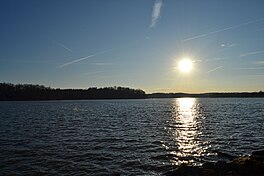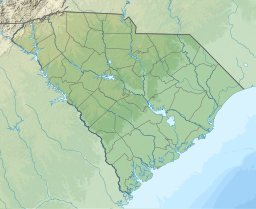Lake Bowen or Lake William C. Bowen is a 1,534-acre (621 ha) reservoir[1] in northern Spartanburg County, South Carolina, 6 miles (10 km) from the North Carolina border. The Interstate 26 bridge crosses over Lake Bowen between exits 5 and 10 on Interstate 26. The lake stretches parallel to South Carolina Highway 11. It is the largest lake in Spartanburg County with 33 miles (53 km) of shoreline.[2] The lake is formed by the waters of the South Pacolet River[3] to serve as a public drinking water supply.[4] Rules and regulations were adopted for recreational activities like boating[5] and fishing.[6] There are picnic pavilions, boat ramps, and a playground near the lake. Fish from the lake is safe to eat.[7]
| Lake Bowen | |
|---|---|
 Sunset at Lake Bowen | |
Location within South Carolina | |
| Location | Spartanburg County, South Carolina, United States |
| Coordinates | 35°06′43″N 82°02′30.9″W / 35.11194°N 82.041917°W |
| Type | reservoir |
| Primary inflows | South Pacolet River |
| Basin countries | United States |
| Surface area | 1,534 acres (621 ha) |
| Max. depth | 41 ft (12 m)[1] |
| Shore length1 | 33 miles (53 km) |
| Surface elevation | 815 ft (248 m) |
| Settlements | Boiling Springs, Inman, Chesnee |
| 1 Shore length is not a well-defined measure. | |
Gallery
edit-
Fish from the lake is safe to eat.
-
SC Hwy 9 bridge in Inman, SC
-
There are boat ramps, and a playground near the lake.
-
The lake is formed by the waters of the South Pacolet River to serve as a public drinking water supply.
-
Abundance of wildlife around Lake Bowen.
-
Some areas are developed real estate.
-
Rules and regulations were adopted for recreational activities like boating and fishing.
-
It is a 1,534-acre (621 ha) reservoir in Spartanburg County, South Carolina, with 33 miles (53 km) of shoreline.
References
editWikimedia Commons has media related to Lake Bowen.
- ^ a b "Limnological Conditions in Lake William C. Bowen" (PDF). U.S. Geological Survey. Retrieved 8 April 2017.
- ^ "Bathymetry of Lake William C. Bowen" (PDF). US DEPARTMENT OF THE INTERIOR. Retrieved 8 April 2017.
- ^ "Spartanburg Water, Upstate Forever partner to protect drinking water". GateHouse Media, Inc. Retrieved 8 April 2017.
- ^ "GEOSMIN OCCURRENCE IN LAKE WILLIAM C. BOWEN". U.S. Geological Survey. Retrieved 8 April 2017.
- ^ "Plan would raise 3 Bowen bridges". GateHouse Media, Inc. Retrieved 8 April 2017.
- ^ "Spartanburg Water System Policies and Procedures for Use of Water Supply Reservoirs" (PDF). Spartanburg Water. Retrieved 8 April 2017.
- ^ "Waterbodies with No Advisories; Eat as much fish as you would like from the following waterbodies". South Carolina Department of Health and Environmental Control. Retrieved 10 April 2017.
